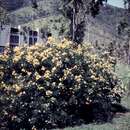Physical Description
provided by USDA PLANTS text
Perennial, Trees, Woody throughout, Stems woody below, or from woody crown or caudex, Stems erect or ascending, Stems or branches arching, spreading or decumbent, Stems greater than 2 m tall, Stems solid, Stems or young twigs sparsely to densely hairy, Leaves alternate, Leaves petiolate, Extrafloral nectary glands on petiole, Stipules inconspicuous, absent, or caducous, Stipules setiform, subulate or acicular, Stipules deciduous, S tipules free, Leaves compound, Leaves even pinnate, Leaf or leaflet margins entire, Leaflets opposite, Leaflets 10-many, Leaves glabrous or nearly so, Inflorescences racemes, Inflorescence panicles, Inflorescence axillary, Inflorescence terminal, Bracts very small, absent or caducous, Flowers actinomorphic or somewhat irregular, Calyx 5-lobed, Calyx glabrous, Petals separate, Petals orange or yellow, Fertile stamens 6-8, Stamens heteromorphic, graded in size, Stamens completely free, separate, Filaments glabrous, Anthers opening by basal or terminal pores or slits, Style terete, Fruit a legume, Fruit stipitate, Fruit unilocular, Fruit freely dehiscent, Fruit elongate, straight, Fruit oblong or ellipsoidal, Fruit exserted from calyx, Fruit compressed between seeds, Fruit glabrous or glabrate, Fruit hairy, Fruit 11-many seeded, Seed with elliptical line or depression, pleurogram, Seeds ovoid to rounded in outline, Seed surface smooth, Seeds olive, brown, or black.
Senna multijuga: Brief Summary
provided by wikipedia EN
Senna multijuga, the November shower or false sicklepod, is a species of flowering plant in the family Fabaceae. It is native to wet tropical areas of Latin America, and widely introduced to other tropical locales such as Africa, India, Indonesia, China, Australia, and Hawaii. A fast-growing tree typically 10 m (33 ft) tall, it is planted in restoration projects, as an ornamental, and as a street tree, being especially useful under power lines.
- license
- cc-by-sa-3.0
- copyright
- Wikipedia authors and editors

